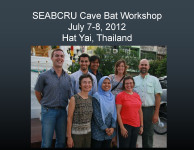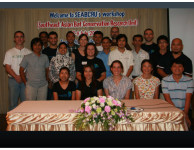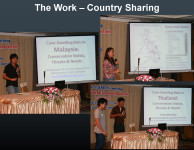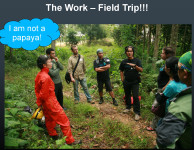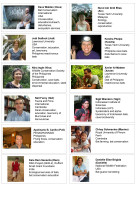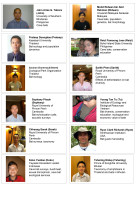Facilitators: Dave Waldien (Bat Conservation International), Neil Furey (Fauna & Flora International), Nina Ingle (Wildlife Conservation Society of the Philippines), Jodi Sedlock (Lawrence University), Kendra Phelps (Texas Tech University), Sigit Wiantoro (Indonesian Institute of Sciences), Ain Elias (Texas Tech University), Xavier Al-Mateen (Lawrence University)
The cave bat workshop aimed to bring together researchers from throughout SE Asia with some experience with or investment in cave bat research and/or conservation. Each participant had an opportunity to summarize the status of cave bat research and conservation in his or her country, including on-going research initiatives and predominant threats to cave bat populations, and to suggest future research and conservation priorities. As a group, we discussed strategies for going beyond single-visit assessments to long-term monitoring of populations using methods that are both effective and practical in the SE Asian context. We made a field trip to caves with bats to demonstrate different methods.
Workshop participants: The cave bat workshop included 16 participants from seven SE Asian countries (Malaysia, Philippines, Indonesia, Cambodia, Vietnam, Thailand, Laos) and India and the United States. Check everyone out at the Field Guide below:
Workshop Objectives
- Participants from different countries in SE Asia will develop rapport with each other and workshop facilitators such that they are comfortable communicating and collaborating on cave bat work.
- Participants will share information about cave bat issues and work being done in SE Asia regarding cave bat assessment and monitoring
- Participants will gain knowledge to design monitoring protocols for cave bats that utilize different methods to answer identified goals and objectives.
Summary of current cave bat research and conservation efforts
Participants representing six countries gave 5-minute presentations summarizing the status of cave bats and current conservation/research activities. These presentations highlighted the lack of basic knowledge regarding the distribution and diversity of cave bats across the region; however, some countries (e.g., Malaysia and Philippines) were clearly ahead of others (e.g. Cambodia). As a result, regardless of country, current research activities were predominately bat surveys in caves and karst areas. Only Thailand (Craseonycteris thonglongyai) and Malaysia (Penthetor lucasi) had population-level studies in place for particular cave bat species. This lack of long-term population monitoring emerged as an obvious gap needing to be filled.
Across all countries, the largest known cave bat populations were of Chaerephon plicatus, reaching approximately 1 million individuals at individual colonies in Cambodia, Malaysia and Thailand. Rousettus amplexicaudatus was also found in large populations throughout the region, including the largest known colony on Samal Island in the southern Philippines. Less was known from all countries about rare cave-dwelling bats or bats that form smaller colonies. Rare species identified included Nycteris javanica and Coelops frithii in Indonesia and Dobsonia chapmani in the Philippines.
General threats to caves and cave bats were similar across countries, including limestone and phosphate mining, guano harvesting, hunting, tourism and habitat loss; however, the importance of each varied from country to country. For example, limestone/phosphate mining was identified as a nationwide priority threat in Cambodia, Indonesia and the Philippines, but not in other countries. Guano harvesting was seen as a nationwide priority in Malaysia and Thailand, but of only local importance in Cambodia and Vietnam. The expansion of tourism into caves was a major concern in Thailand, Vietnam and the Philippines.
- SEABCRU Cave Bats, Cambodia Country Summary
- SEABCRU Cave Bats, INDONESIA Country Summary
- SEABCRU Cave Bats, MALAYSIA Country Summary
- SEABCRU Cave Bats, Philippines Country Summary
- SEABCRU Cave Bats, THAILAND Country Summary
- SEABCRU Cave Bats, Vietnam Country Summary
Monitoring Methods
To identify important research questions and explore the complexities of designing a field study in different cave contexts, we provided the participants three unique scenarios. Each breakout group was given one field scenario (e.g., large, multi-entrance cave with large single-species colony vs. hard-to-access cave with multiple species) and asked to develop a research question that could be answered with monitoring data, to design the sampling protocol and a plan for data analysis, results dissemination and translating these into management action. The three research questions focused on factors that can influence bat population adversely—guano harvesting, cave tourism and bushmeat hunting. Common challenges that emerged were how to arrive at accurate and repeatable methods for estimating population sizes (which differed according to cave context).
We also visited a nearby cave and discussed the best monitoring design for that particular cave the following morning. This resulted in a lively discussion of the pros and cons of different field methods and underscored the need for flexible monitoring guidelines that can be tailored to each field situation.
- SEABCRU Cave Bats, Field Methods – Live Traps & Acoustics
- SEABCRU Cave Bats, Field Methods – Reproduction
- SEABCRU Photographic Techniques, 2012
- SEABCRU Cave Bats, Surveys vs. Monitoring
Suggested Actions to improve monitoring and conservation regionally
Monitoring:
- Develop a flow chart outlining how to set up a monitoring program
- Develop a standardized Southeast Asian cave bat monitoring data sheet
- Continue to work on capacity building in countries with few bat researchers (e.g. Cambodia, Laos)
- Enhance collaborations with entomologists, archeologists, geologists, etc.
- Develop ecological questions that can be answered by looking at caves over time in different areas
- Compile literature on known bat populations
- Start monitoring a cave population in selected countries
Conservation:
- Identify research priorities for cave bat conservation
- Develop a system (index?) to prioritize caves for conservation (Bat Conservation International is working on this at a global scale)
- Create standardized guidelines for guano harvesting
- Initiate education campaigns in communities harvesting bats for food and harvesting guano
- Develop, collate and make accessible education materials for local people

